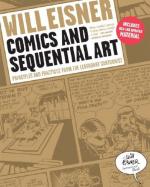
|
| Name: _________________________ | Period: ___________________ |
This test consists of 5 short answer questions, 10 short essay questions, and 1 (of 3) essay topics.
Short Answer Questions
1. In what vocabulary are body and gestures and postures stored?
2. What are gestures "almost idiomatic" to?
3. What is the title of Chapter 7?
4. What determines how successfully the commonality of the human body is conveyed?
5. How many points does Eisner say an artist must understand about how objects work?
Short Essay Questions
1. What temptation do artists have to detract from the text?
2. Why do people make important daily judgments about faces?
3. Why does Eisner reproduce several pages from his graphic novel To the Heart of the Storm along with a close-up pencil dummy page?
4. Explain why comic writers first create a written script of their idea and story/plot, including narrative and dialog (balloons).
5. How are comic book artists most challenged in portraying amorphics?
6. Why are technical skills mandatory for comic book artists?
7. Give a brief synopsis of Chapter 7.
8. Why does artwork dominate the reader's initial response?
9. Contrast gesture and posture.
10. Give a brief synopsis of Chapter 5.
Essay Topics
Write an essay for ONE of the following topics:
Essay Topic 1
Eisner uses four drawings in Chapter 5 to demonstrate the power of facial expressions. Examine the following idea of the face as the "window to the mind" in relation to these four drawings. How can drawing faces in comics be revealing? What sort of things can be revealed by faces in comics?
Essay Topic 2
In Chapter 4, the emphasis on the artist's particular "style" in comics demonstrates that there are many styles to choose from and that each has its own unique characteristics. However, the artist's style must still express meaning to the audience. Discuss four ways in which an artist's style can help or hinder the audience to understand a comic.
Essay Topic 3
Chapter 3 analyzes the relationship between space, time, and visual perspective. Eisner explains that distance is often measured by sight and sound, but it is more difficult to assess time, because it is more illusory. Compile at least three examples provided by Eisner's work and examine the similarities and differences between how time, sight, and sound are measured and expressed in comics.
|
This section contains 776 words (approx. 3 pages at 300 words per page) |

|




